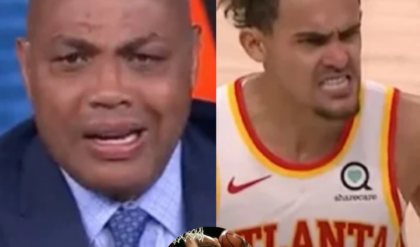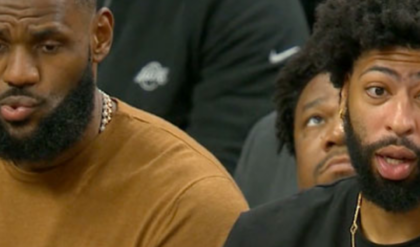They wanted to get Curry breathing room to create offe
/cdn.vox-cdn.com/uploads/chorus_image/image/73237955/2110570019.0.jpg)
The Golden State Warriors were inflicted with a serious case of no Draymond Green early in their game against the Orlando Magic.
But rather than talk about the unnecessary ejection (on Green’s part, mind you), I want to talk about how the Warriors were able to eke out this much-needed win over the Magic, who are — in several ways — a perfect foil for the diminutive and largely unathletic Warriors.
A bunch of long arms, plenty of personnel whose height ranges from 6’7” to 6’11”, and roster-wide excellence in several defensive concepts — in particular, when it comes to screen navigation — constitute the recipe to give the Warriors all the trouble in the world.
The best screen navigator on the Magic — who has a legitimate argument for being the best screen navigator in the league (perhaps bested only by Derrick White) — is Jalen Suggs.
Suggs is getting All-Defensive-Team buzz, and rightfully so.
He is a hound at the point of attack — mobile, agile, physical, and highly aware of his surroundings.
He’s listed at 6’5” and is often tasked by the Magic to guard the opposing team’s best perimeter scorer/shot creator.
Whenever Suggs can stay attached to someone like this, he proves that he’s one of a few defenders in the league who are darn-near impossible to shake off:
As was the case in past contests, Suggs got the Steph Curry assignment — and as was the case in the clip above, he tried his hardest to stick to Curry like his life depended on it. He slithered his way past screens in a fundamentally sound manner (i.e., getting “skinny”), aided by his natural gifts as an athlete:
It’s virtually a death sentence of a possession if you find yourself having to dribble away from Suggs — towards an inanimate defender like the sideline or baseline. It’s fodder for Suggs to hound, trap (with the aid of a teammate) and blow up a possession:
The floor awareness is sublime. He keeps his attention evenly divided between Curry and the ball, enough for him to not be caught on the “Hammer” screen for Curry. He doesn’t run out of energy and verve after the Hammer action; he chases Curry on the DHO, and with the aid of teammates who step up to close Curry’s space around the handoff, Suggs is able to recover in time to help force the miss:
It contributed to another overall off shooting night for Curry, who put up 17 points on 6-of-18 shooting (3-of-10 on twos, 3-of-8 on threes) and 45% True Shooting. In the grand scheme of the game, Curry had the requisite scoring support he needed to power through the Magic, who are the second-best defensive team in the league (111.6 defensive rating in non-garbage time). Four of his teammates put up double-digit scoring: Klay Thompson (15), Moses Moody (12), Gary Payton II (10), and — the one who carried the scoring load in the fourth quarter — Andrew Wiggins (23).
(More on Wiggins later, whose scoring was a much-needed boost.)
When the second half began, there was a noticeable effort to scheme half-court sets geared toward separating Suggs from Curry, in order to provide him with more breathing room. It wasn’t from completely novel sets that got him the space he needed — rather, it was slight tweaks to familiar sets that Steve Kerr used to scheme Suggs away from his superstar.
The first instance generated a wide-open look for Curry that just missed. But the process that led to it was sound:
The tweak to an otherwise typical split action above: having Curry set the split-cut screen for Payton, who then turns around to set the screen for Curry (this concept is called a “Korver” screening action, named after Kyle Korver). This gets Suggs to trail behind, leaving Curry open for a good look.
Another tweak to a staple set, this time on “Head Tap,” which is typically cross-screen action (a screen underneath the rim) for someone to post up on the opposite block. The Warriors started the game with this set for Wiggins, who scored on a jump hook against Markelle Fultz:
A modified version of “Head Tap” — which appears as if it was an on-the-fly read by Curry — gets him separation from Suggs (courtesy of Brandin Podziemski solid cross screen) and allows him to drill an open corner three:
In the fourth quarter, they went back to the tweaked “Korver” split action — and produced an open three for Wiggins on the left wing:
The subtlety of Curry’s screening in the action above is fun to pore over. He comes over to set the screen on Payton’s man (Joe Ingles). Ingles obviously isn’t in a hurry to fight over toward Payton. But this is a decoy for Curry’s actual intention — to position his defender (Cole Anthony) behind Ingles in a way that when Payton turns around to set the screen for Curry, Anthony gets caught on the screen and trails behind.
This induces panic — both Ingles and Anthony jump out toward Curry, freeing the short roll for Payton. Jonathan Isaac is compelled to help off the left wing to switch onto Payton on the short roll. Payton makes the correct read by swinging the ball to the open Wiggins, who drills the wide-open three. This shot was what got Wiggins going in the fourth quarter, in which he scored 13 of his 23 points.
The Warriors seemed content to give Wiggins rep after rep on offense and centered some of their half-court concepts around him. They made sure to bring a mismatch target by having Curry set an inverted ballscreen (a small setting a screen for a big/wing) in order to bring Anthony into the action.
Anthony, however, doesn’t want to detach from Curry and doesn’t want to switch onto the bigger Wiggins — resulting in this:
In his efforts to stay attached, Anthony acts as a screener of sorts for his own teammate. Issac tries to duck under the screen by Curry and Anthony — which gives Wiggins the room he needs to drill the shot.
Anthony doesn’t manage to avoid the mismatch hunt on another inverted-ballscreen possession later on — and Wiggins punishes the matchup by going to the rim, plus the foul:
Beyond the half-court schemes, I was also impressed with Wiggins’ aggression. You rarely see him display the kind of assertiveness and verve that many Warriors’ fans have wanted to see out of him all season long — and the kind that was prevalent throughout his 2022 All-Star/championship campaign.
An aggressive Andrew Wiggins on drives is always a pleasant sight to see, and even more pleasing if it becomes a nightly thing:
An engaged Wiggins who takes it upon himself to score using the holes created by Curry translates into the kind of player he transformed into during their last title run. Along with Thompson and Jonathan Kuminga, a wing room that scores and prevents scoring on the other end is the recipe for success — as it has always been during the entirety of their dynastic run.
nse. The result was Wiggins capturing a scoring rhythm.





